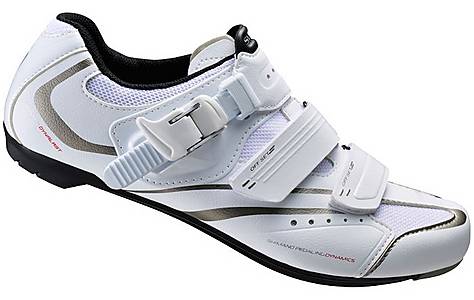Why you should be wearing cycling shoes

Clipless pedals physically 'connect' you to the bike...
I remember when I was about 12 years old living on a street with a small bike shop at the end of the road and I wanted SPD pedals for my bike. I had seen them on the Tour de France and wanted to try some for myself. My Mum said that they were a bit dangerous and you shouldn't be physically connected to your bike, so I never bought them.
My first pair of cycling shoes...
A 'few' years later, my first pair of cycling shoes was a brand new pair of Shimano SPD pedals with SPD-SL cleats similar to the model here. This is a popular type of pedal in racing circles and is commonly used within the road cycling community due to a wider shoe/cleat contact area. I loved using them immediately and I try and convince everyone who doesn't use cleats to at least give them a go.
At first, I felt daunted about using them on the road and my brain did not like the idea of being physically attached to your bike. This was especially worrying on my busy commute home through Greater Manchester where there are lots of traffic lights and stop/start cycling.
I'm scared! What if I need to get my feet out quickly..?
One of the main fears that people have when using SPD pedals with cycling shoes for the first time is that you will not be able to release your feet in time when you need to stop. Good examples include traffic lights, urban traffic and in tight spots such as corners.
Be warned. You will probably fall off at some point!
Everyone does, but don't let this put you off. I fell off using my cycling shoes just standing still waiting to set off as I forgot that I was attached to my bike. It didn't hurt (other than mild embarrassment), but it is true that you never forget your first time!
You can see the many examples of cycling shoes here in Halfords. Just be warned, if your riding involves lots of stopping off, cafe breaks and walking around train stations, then certain types such as SPD-SL are not ideal. The cleat plates are slippery and difficult to walk in.
If you are worried about not being able to release your ankle quickly, you can easily adjust the spring tension on the pedals, so you can remove your feet fast if required. You can also choose different types of cleat systems that are easier to use or offer faster 'snap-on' or 'snap-out'.
Shimano Pedal Dynamics (SPD) Shoes and Cleats...
One of the easiest types to use is the standard Shimano SPD system (pictured above). I prefer using this type of pedal on my hybrid bike and mountain bike due to the easy release if you have to stop suddenly or clip-in quickly to ascend a steep hill.
The contact area between the shoe and pedal is smaller, so there is not as much power being pushed through the cranks. I also find this system to be more comfortable too as the shoe is less rigid and easier to walk in. If I am doing a cycle tour and do not want to take an additional pair of shoes, then I will always swap my pedals over to the SPD system so I can cycle and walk easily.
Look after the cleats and you will look after yourself...
The one piece of advice that I will give from experience is that looking after the cleats and shoes is essential. I have nearly slipped over walking on countless occasions by wearing down the cleat plates on my cycling shoes. You'll be amazed at how walking can feel like ice skating when the cleats are worn down!
To allay your fears of not being able to un-clip when you need to, always set the tension to loosely fitting and then tighten up to an amount of movement that you feel confident using. Also ensure that the cleats and pedals are well maintained, rust-free and that you clean any mud or dirt away from the contact plates.
Ensure that the angle of your knees and cleat position is not giving you any leg pain. Just think about the number of pedal revolutions that you make on a ride and the potential damage caused if your cleats are not in the optimal position for you.
Buy some overshoes when you buy your cycling shoes...
One of the easiest things that you can do to remain comfortable on the bike are overshoes and are useful additional when buying cycling shoes.
Overshoes slot over the cycling shoe leaving space for the cleat to attach to the pedal underneath. On a cold day, you will be glad of your overshoes as they block most of the wind and will keep your toes toasty.
If it is raining, then using overshoes will act as a waterproof layer and can stop a rainy day ride turning completely miserable. Not much is worse than cold feet on a ride.
Remember, you are 30% more efficient with SPD shoes...
The one overriding benefit for cycling shoes with SPD pedals vs. trainers and regular flat pedals regardless of your cycling discipline is that cycling shoes are 30% more efficient. You receive both a push and pull stroke with each pedal revolution, so you can ride further easier.
In conclusion, whether you are looking to buy a pair of cycling shoes for the first time, upgrade to a new pair or change pedal types, then cycling shoes should be an essential part of your cycling kit. They can quickly turn you into a more efficient rider, a more confident cyclist and above all, make you ride further and faster!
You can see the wide choice of cycling shoes, pedals and overshoes available here at www.halfords.com













Thank youu